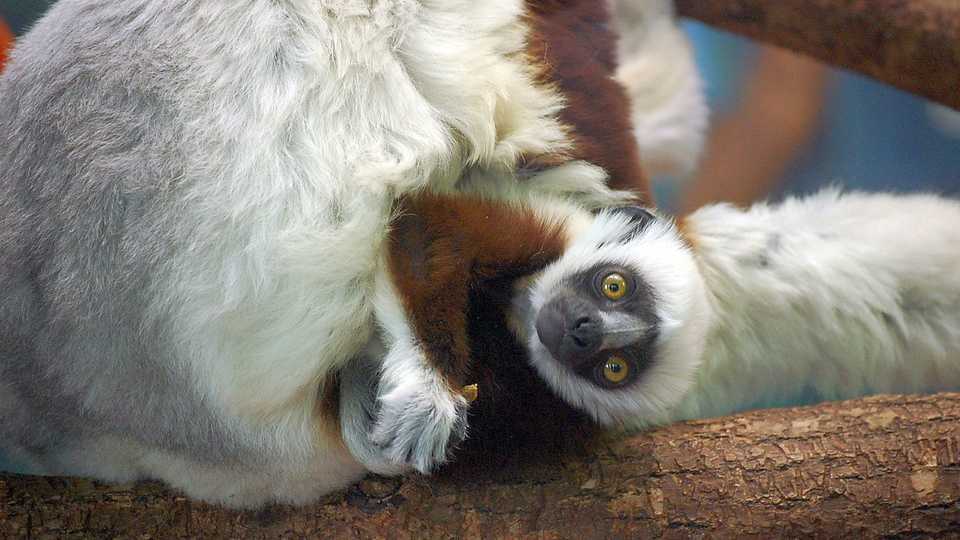Science News
Mother’s Day in the Natural World

Cravings, crankiness, predictions and pregnancy
Ultrasounds are pretty good at predicting the gender of human babies, but scientists studying lemurs may have found an even easier prediction method for that species. Duke University researchers say that pregnant lemurs carrying boys smell different from those carrying girls. The complex mix of pheromones and other chemicals that make up a female lemur’s scent is markedly simpler when she is pregnant with a boy. The reasons behind the odor difference are still a mystery. But Christine Drea, a professor of evolutionary anthropology at Duke, says “the difference in hormone profiles between pregnant lemurs carrying sons and those carrying daughters is dramatic.”
Pregnancy cravings can sometimes include peanut butter or pickles, but poison? Researchers in Japan have discovered that tiger keelback snakes are more likely to eat poisonous toads for dinner while pregnant. Tiger keelbacks have glands on their necks that contain poisons called bufadienolides that are used for defense. But the snakes don’t produce the toxin themselves: they must eat certain poisonous toads to get it. When Kyoto University scientists studied the eating habits of male, non-pregnant female, and pregnant tiger keelbacks, they found that the males and non-pregnant females more often went hunting for the common, non-toxic species of frogs in their habitats. But the pregnant females showed a clear preference for the rarer poisonous prey. The researchers say the mothers might be loading up on poisonous frogs in order to pass on enough defensive toxin to the babies to hold them over until they can begin hunting for the toads themselves.
Pennsylvania State University scientists have discovered that, in scorpions, the ability to procreate has affected female “moods.” Female striped bark scorpions have shorter legs than males, and perhaps, shorter tempers. “Males, unburdened by parenthood, are effective sprinters that have evolved longer legs to support predator evasion…” the researchers say. Since pregnant scorpions are heavier and can’t scurry away to safety as quickly as their male counterparts, they are more likely to strike in defense. In one “temperament” trial, female striped bark scorpions were 75 percent more likely to strike at a scientist’s menacing forceps than were male scorpions.
Staying power
Orangutan moms are among the most dedicated in the animal world: an orangutan mother is the sole source of food and transportation for her offspring for its first two years of life. The mother orangutan will carry the baby with her at all times for about five years, and breastfeed for about eight years. Youngsters stick close to mom for an average of 10 years before they are able to branch out on their own. Scientists say that this intensive relationship is rare, and most likely only surpassed in length by humans.
Speaking of dedication, this deep-sea octopus was observed protecting her eggs for more than four years, the longest time for any known animal. Researchers at the Monterey Bay Aquarium Research Institute (MBARI) say the brooding octopus was seen at the same dive site for four and a half years, protecting the translucent eggs from predators as they developed, slowly, in the cold, deep water. They estimate her eggs numbered about 160, and say that most octopus hatchlings are basically fully developed miniature adults, able to live on their own and hunt small prey at birth. So the octomom’s long commitment gave her offspring the best chance of survival.
First responder
A recent study of mice mothers shows that a kick of oxytocin helps moms recognize and respond quickly to needy babies. Researcher Bianca Marlin and her colleagues from New York University found that the hormone, released during childbirth, is closely linked to moms’ lightning-quick reactions to baby mice in distress. They demonstrated this effect by giving previously clueless virgin female mice an injection of the hormone and watching the results. The non-moms, who once ignored the pups’ cries like so much din in a noisy room, reacted like real mom pros after receiving the hormone. The scientists say oxytocin seems to help the mice hear the barely audible cries more clearly and realize that they’re meant to react. Marlin says, “It was remarkable to watch how adding oxytocin shifted animal behavior, as mice that didn’t know how to perform a social task could suddenly do it perfectly.”
Keep mom close
For orcas, hanging out with mom well into adulthood appears to be good for longevity. A decades-long study of nearly 600 orcas in the coastal waters off Washington state and British Columbia, found that orcas, especially males, benefit substantially from having mom nearby. In the year after their mother’s death, young male orcas were three times more likely to die than were males whose mothers were still alive. For male orcas older than 30, the death of a mother meant an eightfold increase in the likelihood of death within a year. Female orcas didn’t see quite as much benefit to hanging out with mom, but for those over 30 there were still survival perks. There’s been no report yet, though, on the benefits of time with the in-laws.
Image: MTSOfan/Flickr